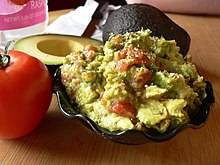Mexican cuisine: Difference between revisions
m Reverting possible vandalism by 205.202.144.162 to version by Gilliam. False positive? Report it. Thanks, ClueBot. (774001) (Bot) |
No edit summary Tag: possible vandalism |
||
| Line 1: | Line 1: | ||
8========================D |
|||
{{distinguish2|[[Tex-Mex|Tex-Mex cuisine]], which is often referred to as "Mexican food" in the U.S}} |
{{distinguish2|[[Tex-Mex|Tex-Mex cuisine]], which is often referred to as "Mexican food" in the U.S}} |
||
{{refimprove|date=December 2008}} |
{{refimprove|date=December 2008}} |
||
Revision as of 15:33, 22 September 2009
8========================D Template:Distinguish2
This article needs additional citations for verification. (December 2008) |

Mexican cuisine is a style of food that originated in Mexico. Mexican cuisine is known for its varied flavors, colorful decoration, and variety of spices and ingredients, many of which are native to the country.
National cuisine



When conquistadores arrived in the Aztec capital Tenochtitlan (now Mexico City), they found that the people's diet consisted largely of corn-based dishes with chiles and herbs, usually complemented with beans and tomatoes or nopales. The conquistadores eventually combined their imported diet of rice, beef, pork, chicken, wine, garlic and onions with the native indigenous foods of pre-Columbian Mexico, including chocolate, maize, huitlacoche, tomato, vanilla, avocado, guava, papaya, sapote, mamey, pineapple, soursop, jicama, chile pepper, beans, squash, sweet potato, peanut, achiote, turkey and a local variety of fish.
Corn is its traditional staple grain, but today, rice is equally important and Mexico's rice harvest is abundant. According to food writer Karen Hursh Graber, the initial introduction of rice to Spain from North Africa in the 4th Century led to the Spanish introduction of rice into Mexico at the port of Veracruz in the 1520s. This, Graber says, created one of the earliest instances of the world's greatest fusion cuisines.[1]
In Pueblos or villages, there are also more exotic dishes, cooked in the Aztec or Mayan style (known as comida prehispánica) with ingredients ranging from iguana to rattlesnake, deer, spider monkey, grasshoppers, ant eggs, and other kinds of insects.
Common dishes on a national level
Regional cuisine


Mexican food varies by region, because of local climate and geography and ethnic differences among the indigenous inhabitants and because these different populations were influenced by the Spaniards in varying degrees. The north of Mexico is known for its beef, goat and ostrich production and meat dishes, in particular the well-known Arrachera cut.
Central Mexico's cuisine is largely made up of influences from the rest of the country, but also has its authentics, such as barbacoa, pozole, menudo and carnitas.
Southeastern Mexico, on the other hand, is known for its spicy vegetable and chicken-based dishes. The cuisine of Southeastern Mexico also has quite a bit of Caribbean influence, given its geographical location. Seafood is commonly prepared in the states that border the Pacific Ocean or the Gulf of Mexico, the latter having a famous reputation for its fish dishes, a la veracruzana.
In modern times, other cuisines of the world have become very popular in Mexico, thus adopting a Mexican fusion. For example, sushi in Mexico is often made with a variety of sauces based on mango or tamarind, and very often served with serrano-chili blended soy sauce, or complimented with habanero and chipotle peppers.
Mexican cuisine outside of Mexico

Mexican food is widely available north of the U.S.-Mexico border. Cultural influences left from Spanish colonization of the Southwest and California remain not only in the names of places but also in the ingredients in cooking; this influence is strongly reinforced today by their proximity to Northern Mexican states like Sonora, Baja, and Chihuahuha. New Mexico still has a tradition of cooking more closely related to Mexico than to any of its Anglophone neighbors and bears traditional dishes with decidedly Spanish names, like sopapillas. Prickly pears are as popular a food North of the border as they are South (often made into jams.) Ingredients common to both sides include chili peppers (the genus 'capsicum' reaches its Northern limit in Nevada,) maize, beans, tomatoes, tortillas, tequila, and beef (both areas have a strong tradition of cattle ranching.) However, there is definite Americanization and hybridization the farther one is away from Mexico, resulting in Tex-Mex cuisine. Nachos for example are rarely eaten in Mexico, whereas they are wildly popular in the rest of the world.
Another example is how in some regions of Mexico, it is very unusual to put cheese in tacos or tostadas (unless it is the typically Mexican panela cheese). However in southern Mexico is common to use cheese in both tacos and tostadas and in other Mexican dishes such as picadas and enchiladas.
The six regions of Mexico differ greatly in terms of cuisine-style; it is almost as if each region is their own separate country with separate cuisines. In the Yucatan, for instance, a unique, natural sweetness (instead of spiciness) exists in the widely used local produce along with an unusual love for achiote seasoning. In contrast, the Oaxacan region is known for their savory tamales and celebratory moles, while the mountainous regions of the West (Jalisco, etc) are known for goat birria (goat in a spicy tomato-based sauce).

While Mexican Restaurants can be found in almost any town throughout North America, and in many cities around the world, restaurants outside the American Southwest often feature nontraditional ingredients, such as grated American-style cheese, "nacho" cheese or tomato-based sauce substitutes for Mexican chile-based sauces or mole. States bordering Mexico (Texas, New Mexico, Arizona, California) as well as Colorado and Utah have large expatriate Mexican populations, which has produced a variety of authentic Mexican restaurants. In other areas of the United States and Canada, Mexican dishes and restaurants vary as much as Chinese restaurants and dishes do between China and many locations in the western Hemisphere.

See also
References
- ^ Hursh Graber, Diana. "Rice, the Gift of the Other Gods" 2003.
